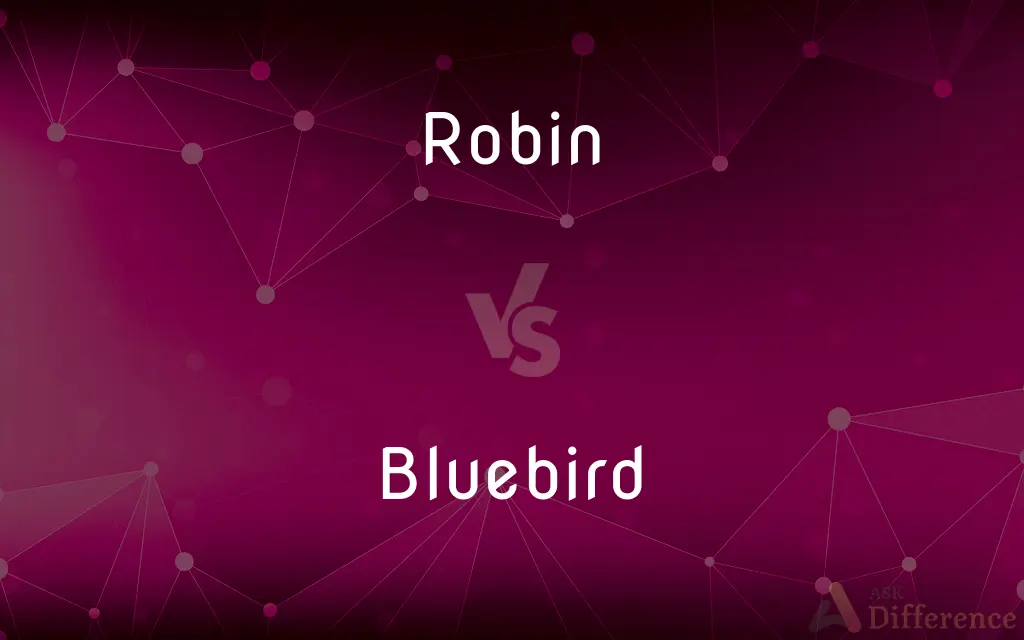Robin vs. Bluebird — What's the Difference?
Edited by Tayyaba Rehman — By Urooj Arif — Updated on April 14, 2024
Robin is known for its distinctive orange-red breast and melodic song, thriving in varied habitats, while the bluebird displays vibrant blue plumage and prefers open woodlands.

Difference Between Robin and Bluebird
Table of Contents
ADVERTISEMENT
Key Differences
The robin, officially known as the American Robin, is characterized by its striking orange-red breast and is a common sight in many North American gardens. Whereas, the bluebird, particularly the Eastern Bluebird, features vivid blue plumage, which is especially pronounced in males.
Robins are adaptable birds that can thrive in a variety of environments, including urban areas. On the other hand, bluebirds tend to prefer open woodlands and are often found in more rural settings, nesting in cavities or birdhouses provided by enthusiasts.
The diet of a robin is quite diverse, consisting of insects, fruits, and berries. Whereas bluebirds primarily eat insects and small fruits, making them highly beneficial for natural pest control.
Robins are year-round residents in many parts of their range, often seen hopping on lawns. In contrast, bluebirds are partially migratory, depending on the climate and food availability, which influences their presence in certain areas throughout the year.
The nesting habits of robins involve building a nest of twigs and grass, typically in trees or shrubs. Meanwhile, bluebirds are cavity nesters, often relying on old woodpecker holes or artificial nest boxes for breeding sites.
ADVERTISEMENT
Comparison Chart
Plumage
Orange-red breast, gray upper parts
Bright blue upper parts, red underparts
Habitat
Urban gardens, forests, fields
Open woodlands, rural areas
Diet
Insects, fruits, berries
Insects, small fruits
Migration
Non-migratory or short-distance migrant
Partially migratory
Nesting
Builds nests in trees or bushes
Uses cavities or nest boxes
Compare with Definitions
Robin
A medium-sized bird known for its orange-red breast and melodious song.
The robin’s song is often heard at dawn.
Bluebird
Primarily insectivorous but also eats berries.
Bluebirds gather at fruiting bushes to feed in early autumn.
Robin
Eats a diverse diet including insects and fruits.
The robin pecked at the ground, searching for worms.
Bluebird
Uses cavities for nesting, often dependent on nest boxes.
The bluebird inspected the nest box installed by the gardeners.
Robin
Often seen on the ground, foraging alone.
A robin hopped across the lawn after rain.
Bluebird
Migratory habits influenced by food availability and climate.
As winter approached, the bluebirds began their journey south.
Robin
Constructs a sturdy nest using grass and twigs.
The robin built its nest on the lower branch of the oak.
Bluebird
Prefers open woodlands and fields for habitat.
Bluebirds are often spotted perching on fence posts in rural areas.
Robin
Common in various habitats, from urban to wild areas.
Robins are frequent visitors in suburban backyards.
Bluebird
A small bird with striking blue and sometimes red plumage.
The male bluebird's bright blue feathers shimmered in the sunlight.
Robin
A North American songbird (Turdus migratorius) having a rust-red breast and gray and black upper plumage. Also called robin redbreast.
Bluebird
The bluebirds are a group of medium-sized, mostly insectivorous or omnivorous birds in the order of Passerines in the genus Sialia of the thrush family (Turdidae). Bluebirds are one of the few thrush genera in the Americas.
Robin
A small songbird (Erithacus rubecula) of Eurasia and Africa having olive-brown upper plumage and a conspicuous orange breast and face. Also called robin redbreast, ruddock.
Bluebird
An American songbird of the thrush family, the male of which has a blue head, back, and wings.
Robin
Any of various birds resembling a robin.
Bluebird
Denoting or relating to a period of time characterized by sunny, cloudless weather, typically after a night of snowfall
On beautiful bluebird days the girls rode snowmobiles
A week of bluebird skies
The clouds broke, the sun shone down, and the day was bluebird
Robin
Any of various passerine birds (about 100 species) of the families Muscicapidae, Turdidae and Petroicidae (formerly Eopsaltriidae), typically with a red breast.
Bluebird
Any of several North American songbirds of the genus Sialia, having blue plumage and usually a rust-colored breast in the male.
Robin
A European robin, Erithacus rubecula.
Bluebird
Any of various North American birds of the genus Sialia in the thrush family. Their plumage is blue or blue and red.
Robin
An American robin, Turdus migratorius.
Bluebird
Any of various African starlings of the genus Lamprotornis, family Sturnidae, having predominantly glossy blue plumage.
Robin
(historical) A trimming in front of a dress.
Bluebird
A small song bird (Sialia sialis), very common in the United States, and, in the north, one of the earliest to arrive in spring. The male is blue, with the breast reddish. It is related to the European robin.
Robin
A small European singing bird (Erythacus rubecula), having a reddish breast; - called also robin redbreast, robinet, and ruddock.
Bluebird
Fruit-eating mostly brilliant blue songbird of the East Indies
Robin
Small Old World songbird with a reddish breast
Bluebird
Blue North American songbird
Robin
Large American thrush having a rust-red breast and abdomen
Common Curiosities
What distinguishes a robin's diet?
Robin's diet is versatile, including insects and various fruits.
How do bluebirds adapt their nesting habits?
Bluebirds typically nest in cavities or utilize nest boxes provided by humans.
What are the key features of a bluebird’s plumage?
Bluebirds are noted for their vivid blue and sometimes red plumage.
What environments are preferred by bluebirds?
Bluebirds favor open woodlands and rural settings.
How do robins adapt to urban environments?
Robins can thrive in urban settings, often seen foraging in gardens.
What type of migration patterns do bluebirds follow?
Bluebirds are partially migratory, moving based on food availability and climate.
What makes the bluebird beneficial to ecosystems?
Bluebirds help control insect populations through their diet.
Where can robins typically be found?
Robins are adaptable, found in both urban and wild areas.
How do robins build their nests?
Robins construct nests from grass and twigs in trees or bushes.
Are robins social birds?
Robins are typically seen alone or in pairs, especially during breeding season.
Share Your Discovery

Previous Comparison
Anorak vs. Jacket
Next Comparison
Pelmeni vs. PierogiAuthor Spotlight
Written by
Urooj ArifUrooj is a skilled content writer at Ask Difference, known for her exceptional ability to simplify complex topics into engaging and informative content. With a passion for research and a flair for clear, concise writing, she consistently delivers articles that resonate with our diverse audience.
Edited by
Tayyaba RehmanTayyaba Rehman is a distinguished writer, currently serving as a primary contributor to askdifference.com. As a researcher in semantics and etymology, Tayyaba's passion for the complexity of languages and their distinctions has found a perfect home on the platform. Tayyaba delves into the intricacies of language, distinguishing between commonly confused words and phrases, thereby providing clarity for readers worldwide.














































